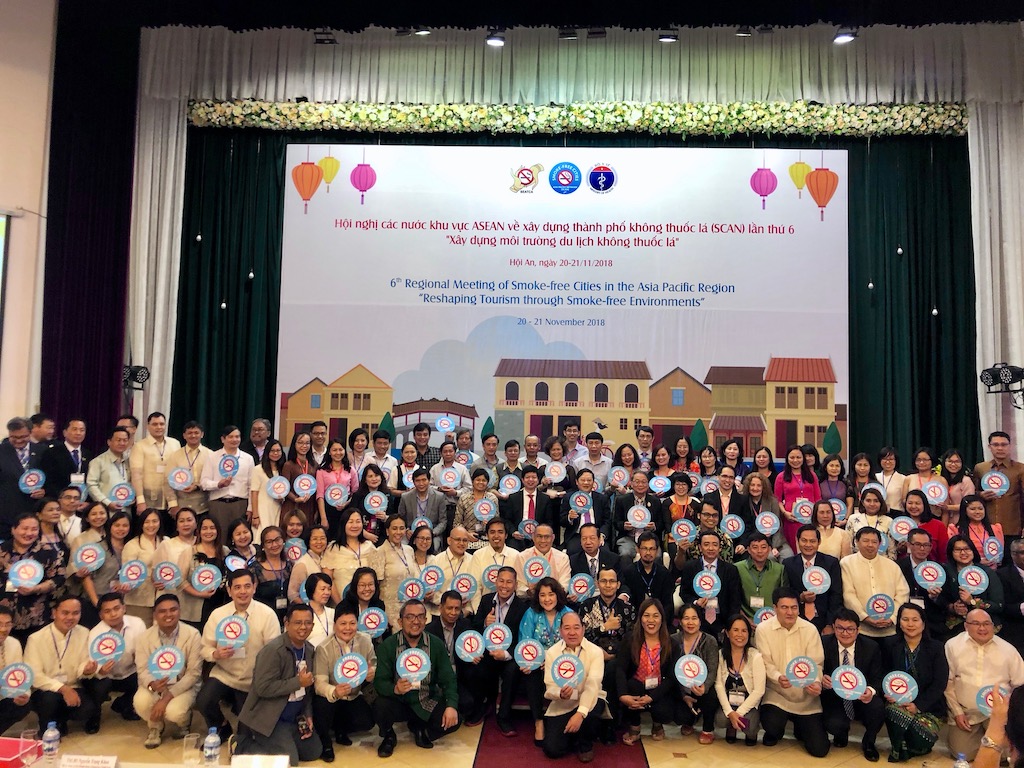Smoke-free tourism - key focus of regional meeting in Hoi An, Viet Nam
.png)

Smoke-free tourism - key focus of regional meeting in Hoi An, Viet Nam
Hoi An, Viet Nam, 20 November 2018: More than 100 smoke-free leaders and representatives from cities all over Asia Pacific are gathered in the Ancient town of Hoi An, Viet Nam to discuss steps to promote and strengthen the smoke-free campaign in different tourist attractions including heritage sites in the region.
The 6th Regional Meeting of Smoke-free Cities in the Asia Pacific Region with the theme: “Promoting Tourism through Smoke-free Environments” happening from 20 to 21 November 2018 hopes to share and discuss strategies, challenges, and plans to strengthen the smoke-free campaign in different tourist spots and promote this campaign as an integral part of tourism.
“Tourism is an important economic driver of cities. Successful tourism relies not only on individual attractions but on a welcoming and healthy environment. It is important to strengthen the smoke-free campaign of tourist spots of cities to maintain fresh air and create a healthy environment for citizens and tourists alike,” said Dr. Domilyn Villarreiz, Smoke-free Program Manager of Southeast Asia Tobacco Control Alliance (SEATCA) and Secretary-General of the Smoke-free Cities Asia Pacific Network (SCAN).
During the two-day regional meeting, the delegates will discuss their plans in integrating smoke-free into their tourism campaigns. SEATCA will also recognize the smoke-free efforts of the different heritage sites highlighting their experiences and best practices in declaring and maintaining the smoke-free campaigns in their areas. Some of the heritage sites that received technical assistance from SEATCA to launch and maintain their smoke-free campaign are Angkor in Cambodia, Borobudur and Prambanan Temple Compounds in Indonesia, Malacca and Georgetown, Penang, Malaysia, Luang Prabang and Vat Phou, Champasak in Lao PDR, the Ancient Town of Hoi An and Ha Long Bay in Vietnam including a known tourist spot of Pindaya Caves in Myanmar.
“Multiple studies show that tourists prefer to travel to places where the environment is healthy and making a tourist attraction 100% smoke-free is a sure way to make it healthy for everyone. A non-smoking environment will also aid in preserving old monuments and buildings and prevent non-biodegradable cigarette butts from littering the environment,” added Villarreiz.
Recognizing the importance of protecting heritage sites from fires and smoke damage due to smoking of tobacco and indiscriminate discarding of cigarette butts and the importance of protecting all people within these sites from the hazards of exposure to secondhand tobacco smoke, conservation authorities should develop and enforce a strong and comprehensive policy to prevent and reduce tobacco-caused damages in order to preserve their cultural and natural values as well as protect staff and visitors from diseases and untimely death.
“In the region, most countries have comprehensive laws in place to create wider and more effective health zones featuring smoke-free workplaces, public transport, restaurants, bars and other public places. We hope this meeting will make more frequently visited tourist attractions in cities smoke-free because smoke-free tourism is not only good for the economy, but more importantly good for health and the environment,” said Villarreiz.
This meeting of smoke-free cities is organized by the Southeast Asia Tobacco Control Alliance (SEATCA), the Smoke-free Cities Asia Pacific Network (SCAN), the Viet Nam Tobacco Control Fund (VNTCF) of the Ministry of Health - Viet Nam in close collaboration with the World Health Organization in the Western Pacific and locally hosted by Hoi An People’s Committee.
Contact:
Wendell C Balderas, Media and Communications Manager – SEATCA
Email: wendell@seatca.org | Mobile: +63 999 881 2117 ##
About SEATCA
SEATCA is a multi-sectoral non-governmental alliance promoting health and saving lives by assisting ASEAN countries to accelerate and effectively implement the evidence-based tobacco control measures contained in the WHO FCTC. Acknowledged by governments, academic institutions, and civil society for its advancement of tobacco control movements in Southeast Asia, the WHO bestowed on SEATCA the World No Tobacco Day Award in 2004 and the WHO Director-General's Special Recognition Award in 2014.

